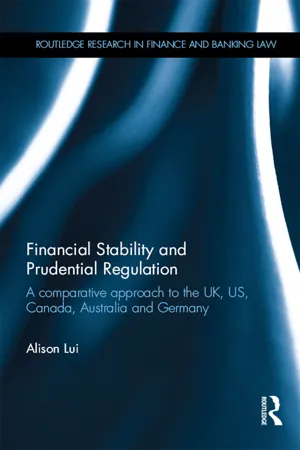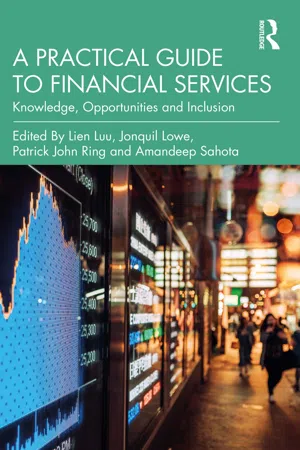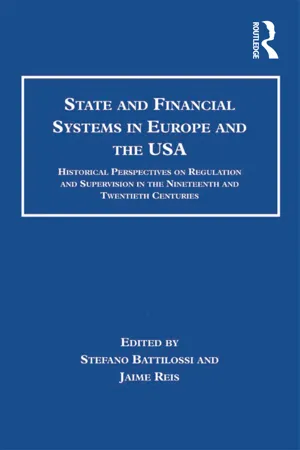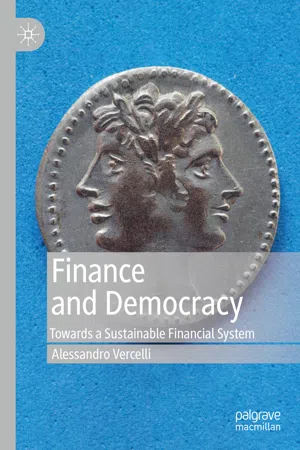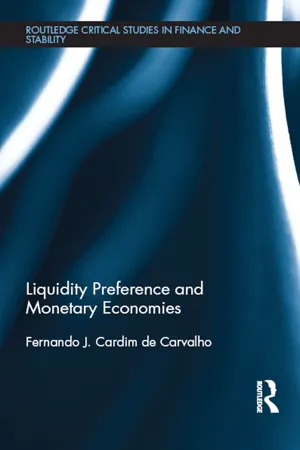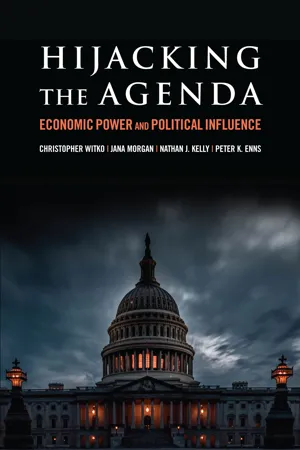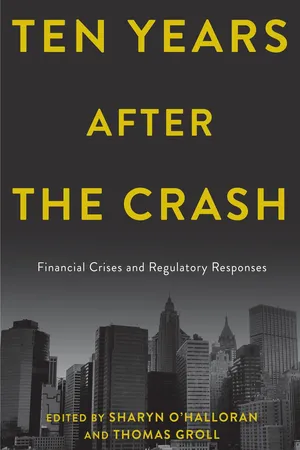Economics
US Financial Regulation
US financial regulation refers to the laws and rules that govern the financial industry in the United States. It aims to maintain stability, protect consumers, and prevent financial crises. Key regulatory bodies include the Securities and Exchange Commission (SEC), the Federal Reserve, and the Consumer Financial Protection Bureau (CFPB). These regulations cover areas such as banking, securities, and insurance.
Written by Perlego with AI-assistance
Related key terms
Related key terms
1 of 4
Related key terms
1 of 3
7 Key excerpts on "US Financial Regulation"
- eBook - ePub
Financial Stability and Prudential Regulation
A Comparative Approach to the UK, US, Canada, Australia and Germany
- Alison Lui(Author)
- 2016(Publication Date)
- Routledge(Publisher)
Financial innovation and stability are difficult to balance. The financial system in the US is the epitome of this difficulty. Ranked first in the Financial Development Index of the World Economic Forum 2012 indexes of non-financial services and financial markets, it is only ranked 38th overall for financial stability (World Economic Forum 2012). The World Economic Forum highlighted this weakness but pointed out that the US improved its ranking for overall banking stability (40th). Statistics from the World Bank also show that in 2009–12, the US had a high ratio of non-performing loans to total gross loans, indicating financial instability. However, this ratio has improved in subsequent years. Undoubtedly, the US suffered financial instability during the financial crisis of 2007–9 since it was at the core of the crisis. Although the American financial regulatory system is complex and fragmented, it is heavily regulated within the banking sector. This chapter studies the roles of shadow banking and securitisation on financial stability as well as important macro-prudential regulatory issues. From a micro-prudential perspective, it is submitted that the Federal Reserve can do more to link monetary policy with micro-prudential regulation. It is also submitted that political influence and lobbying by American politicians have had an impact on the financial regulatory architecture in the US. The pendulum has swung from independent agencies towards more power to politicians in financial regulation after the financial crisis of 2007–9. Whilst banking is always political to the extent that banks are fundamental to a country’s economy, countries such as the US and UK, with large financial sectors, will need political will to make changes for the benefit of society at an international level. Jurisdictional competition for financial services means that regulation of the shadow banking sector remains unlikely since co-operation at the international level remains a real difficulty. Other methods of improving financial stability will thus be investigated in this chapter.The Federal Reserve Board and institutional weaknesses during the financial crisis of 2007–9 The US regulatory structureBen Bernanke, Chairman of the Federal Reserve Board between 2006 and 2014, said that ‘the Federal Reserve has become much more focused on financial stability’ (Bernanke 2013). The Federal Reserve Board is one of four prudential bank regulators in the US financial regulatory system. The other bank regulators are the Office of the Comptroller of the Currency (OCC), Federal Deposit Insurance Corporation (FDIC) and National Credit Union Administration. As prudential regulators, the overriding concept is prudent monitoring and regulating risks of banks (Murphy 2013). Two agencies are in charge of monitoring the information market players provide to customers: the Securities and Exchange Commission (SEC) and the Commodities Futures Trading Commission (CFTC). The US financial regulatory system is complex, and there are regulatory overlaps between the agencies. For example, the bank regulators can regulate the disclosures of their chartered firms, whilst securities and derivatives regulators have some prudential responsibilities. An example is section 731 of the Dodd–Frank Wall Street Reform and Consumer Protection Act 2010 (‘Dodd–Frank Act’). It states that the SEC and CFTC can, after consultation with the prudential regulators, set capital requirements for major swap participants. The largely functional-based approach to prudential regulation is illustrated in the example of regulating the derivatives-trading activities of JP Morgan in 2012 (Murphy 2013). Five US regulatory agencies were involved, starting with the OCC regulating at the depository level. The Federal Reserve was responsible for regulating the same activities at company holding level. The SEC regulated the disclosure of information to shareholders, whilst the CFTC regulated the derivatives transactions. Finally, JP Morgan provides insurance services as well, so it was subject to the regulation of the FDIC. Despite these regulatory overlaps, Congress resisted making architectural changes unless there were faults in the system (Wallace 2013). Further, Gadinis (2013) is of the opinion that the independent-agency model in the US provides a high level of independence amongst financial regulatory agencies, which is an indicator of the quality of financial regulation. For example, Congress has the power to approve the SEC’s annual budget but is restricted in approving the Federal Reserve’s budgetary and audit powers. Yet the financial crisis of 2007–9 proved that there were faults in the financial system. - eBook - ePub
A Practical Guide to Financial Services
Knowledge, Opportunities and Inclusion
- Lien Luu, Jonquil Lowe, Patrick Ring, Amandeep Sahota(Authors)
- 2021(Publication Date)
- Routledge(Publisher)
11 Regulation of financial services Patrick John RingDOI: 10.4324/9781003227663-11Key points summary- There are three objectives of financial regulation: systemic stability, the soundness of individual firms and ensuring that markets work effectively (including appropriate consumer protection). The objectives and theory about how they may be achieved influence the structure of regulation.
- The main front-line tasks for regulators are to authorise appropriate firms to do business, police the perimeter between authorised and unauthorised firms and supervise and enforce compliance with specified rules.
- Consumer protection can take two forms: ex-ante protection focuses on preventing consumer detriment; ex-post protection provides routes for complaints and redress.
- Conventional regulatory measures may be supplemented with innovative approaches, such as ‘nudging’ consumer behaviour and trying to change the culture of firms.
It is fair to say that, in recent years, events in the financial sector have cast a strong light upon the role of national and international regulators of the financial services industry. The Global Financial Crisis (GFC) that started in 2007 – described in Box 1.1 in Chapter 1 – drew attention to the failures of financial regulation, and subsequent financial scandals in many different countries have also drawn attention both to the challenges faced by consumers in navigating their way through an increasingly complicated financial landscape, and to the behaviour of certain individuals and the culture of the firms for which they worked.In this chapter, we begin by looking at the objectives of financial regulation and how that can influence the structure of national regulators. Thereafter, we focus upon the position in the UK, which itself illustrates many of the issues and dilemmas facing regulators around the world. In doing so, we concentrate on three particular issues: the regulatory concerns of front-line regulation, the role of regulators when it comes to the protection of financial services consumers and the regulation concerning the behaviour of individuals and culture of financial firms operating within the financial services sector. - eBook - ePub
State and Financial Systems in Europe and the USA
Historical Perspectives on Regulation and Supervision in the Nineteenth and Twentieth Centuries
- Jaime Reis, Stefano Battilossi(Authors)
- 2016(Publication Date)
- Routledge(Publisher)
CHAPTER 3 Regulation and Governance: A Secular Perspective on the Development of the American Financial System Eugene N. White What accounts for the trajectory of financial regulation in the United States? In this chapter, I argue that the underlying forces driving regulation are the upsurges in productivity growth, rather than periodic crises. More precision can be given to the timing and direction of regulation by treating the financial system as primarily a provider of information rather than liquidity or diversification. During the twentieth century, two productivity surges – one in the first three decades and the other in the 1990s – increased the demand for finance that widened the information asymmetries facing the financial sector. The market responded to these challenges by innovating to provide solutions. Business-cycle shocks then tested institutional governance and the capacity of the market to adequately screen and monitor borrowers. The limitations of the innovations, often constrained by the pre-existing regulations, were highlighted, leading to regulation. Whether this regulation correctly treated a problem or was hijacked by interest groups depended how the political equilibrium was upset by productivity surges. The most widely accepted explanation of why governments intervene in the market is the economic theory of regulation, which had its genesis in George Stigler’s 1971 article. 1 Although the model has been found to be useful in analysing existing regulation, the theory offers limited predictions about the timing of regulation and deregulation. 2 In its basic version, legislators are self-interested maximizers who legislate to ensure their re-election. Politicians provide regulation to rent-seeking groups that offer the best electoral resources in exchange. The ability of any group to deliver resources to politicians depends on the information and organization costs it faces - eBook - ePub
Finance and Democracy
Towards a Sustainable Financial System
- Alessandro Vercelli(Author)
- 2019(Publication Date)
- Palgrave Macmillan(Publisher)
deregulation has always targeted specific rules or practices of the existing model to implement a new regulation model.6.3 Fixing the Fault Lines of the Global Financial System
The Great Financial Crisis of 2007–2009 has deeply affected the global financial system and thus all the economies that are increasingly intertwining with it. It was immediately clear to policymakers and regulators that the fixing of the dire fault lines of the financial system was an urgent priority and required a strict coordination at the global level. In the immediate aftermath of the 2008 crisis, the G20 countries agreed on the urgency of a common set of principles to reform the regulation rules of the financial sector . In the official documents of G20, we find an alleged consensus on what triggered off the financial crisis. The Washington Declaration , issued just after the climax of the crisis (November 15, 2008),11 blamed the widespread pursuit by market participants of higher yields without adequate appreciation of risks and proper due diligence.12 The G20 leaders also pointed out that insufficiently coordinated macroeconomic policies as well as inadequate structural reforms were major factors that contributed to unsustainable global macroeconomic outcomes. Therefore, they agreed to implement in a coordinate way reforms that would strengthen regulatory regimes and financial markets to avoid future crises. In particular, they endorsed an action plan for the re-regulation of the international financial system. This plan aimed to strengthen the transparency and accountability of financial institutions and markets, enhancing sound regulation, promoting integrity, reinforcing international cooperation, and reforming international financial institutions - eBook - ePub
- Fernando J. Cardim de Carvalho(Author)
- 2015(Publication Date)
- Routledge(Publisher)
8 Stability regulationA regulatory revolution took place in the United States in the 1930s in reaction to the crisis. The main initiatives were inspired by the stylized sequence of events presented above. Rules for protecting the integrity of markets were introduced to curb speculation in the securities markets, and more particularly in the stock exchange. A supervisor was created, the Securities Exchange Commission, to supervise these markets. Its mission was to protect investors. Indirectly, it would help to preserve financial stability because it was believed that a properly supervised market, by protecting investors and keeping them adequately informed about the perspectives for their investments, should avoid panic episodes as the one experienced in 1929. A second crucial step was the breaking up of universal banks imposed by the Glass–Steagall Act. It was expected that banning financial conglomerates controlling both commercial banks and investment banks should severe the connections between securities markets and deposit taking activities, thereby preventing the contagion of a segment’s problems to the other. A safety net was created, the main element of which was the introduction of deposit insurance to tranquilize depositors and prevent bank runs. Prudential regulation was imposed on banks to contain their risk exposures and reduce the probability of failure that would activate deposit insurance.The stability strategy devised in the 1930s turned out to be extremely successful. No serious banking crisis occurred in the United States until the 1980s. In time, however, the very success of stability regulation bred complacency. The events triggering the 1930s crisis were reinterpreted. For some analysts, the result of this reinterpretation was to suggest that the crisis was not due to any structural inadequacy of financial systems but to policy mistakes made by the Federal Reserve. The extended experience with stability led many to take it as proof of the intrinsic systemic stability of financial markets. The debate on regulation, particularly in the United States, shifted focus more and more to market distortions supposedly created by the existence of a safety net. Particularly in the 1980s, one would conclude from a cursory examination of the literature on regulation that the main problem faced by the US banking system was moral hazard - eBook - ePub
Hijacking the Agenda
Economic Power and Political Influence
- Christopher Witko, Jana Morgan, Nathan J. Kelly, Peter K. Enns(Authors)
- 2021(Publication Date)
- Russell Sage Foundation(Publisher)
Chapter 6
Financial Re-regulation? Economic Crisis and Shifting Power Dynamics
The [regulatory] failures in Washington and the failures on Wall Street precipitated the worst crisis since the Great Depression, and it is our job here and now to come up with solutions.—Representative Scott Murphy (D-NY), Congressional Record, December 9, 2009We’re completely outgunned. Despite the millions of consumers . . . affected, the money and resources of the banking industry clearly overwhelm us. Even in this crisis, it’s hard for our voice to be heard.—Lauren Saunders, consumer advocate, quoted in the New York Times, March 1, 2010Gramm-Leach-Bliley reset the regulatory framework for the entire financial sector. In the first decade of the new century, its deregulatory approach was further consolidated through both regulatory decisions and direct legislative action. Critics of deregulation had warned of numerous problems—a regulatory scheme that did not make much sense given the new industry structure, mega-banks that were “too big to fail,” and a lack of consumer protections. But it was not until the onset of the 2007–2009 financial crisis, when many of these chickens came home to roost, that policymakers confronted the potential hazards of a lack of financial regulation and an outdated regulatory system.In this chapter, we analyze the issue agenda and policymaking regarding financial regulation in the post-crisis period, which culminated in the Dodd-Frank Wall Street Reform and Consumer Protection Act of 2010. The previous chapter considered how structural and kinetic power shape the congressional agenda under typical circumstances in which economic elites possess considerable structural and kinetic advantages. In contrast, here we examine a policy moment when wealthy financial-sector interests suffered an unusual challenge to their structural power while also confronting more serious opposition from consumer groups that mobilized in the wake of the crisis and leveraged resources toward regulatory renewal. As we will see, finance was incapable of keeping reform completely off of the agenda, but its power still played an important role in keeping certain proposals off the table and limiting the scope of reform, underscoring the ways in which wealthy interests shape the policy agenda in Congress at both a macro and a more micro level. - eBook - ePub
After the Crash
Financial Crises and Regulatory Responses
- Sharyn O'Halloran, Thomas Groll(Authors)
- 2019(Publication Date)
- Columbia University Press(Publisher)
Although there was (and remains) some desire to dampen the macro-credit-asset price boom-and-bust “cycles” that have characterized financial capitalism since the nineteenth century and earlier, the dominant goal was to increase the resilience of the financial system as a whole. As part of that, there was a shift away from relying almost wholly on prophylactic regulation and supervision (i.e., trying to reduce the probability of distress and failure among financial intermediaries). Instead, almost equal billing was given to containing and mitigating the social costs of distress and failure when it occurs. The Reliance on Rules If that was a notable departure from half a century’s substantive orthodoxy, in other respects—especially in the form of the reforms—it seemed to be business as usual. In particular, everywhere the new policies were implemented via new domestic regulations that were so voluminous—thousands of pages of them—that they seemed to ignore one of the deep flaws in the precrisis regime: that labyrinthine rule books are an open invitation to regulatory arbitrage that has the perverse effect of undermining the very systemic resilience they are designed to underpin. Meanwhile, the scandals and detritus revealed as the financial tide went out raised questions about ethics and culture that could not obviously be fixed by more rules, vital though it was to remedy gaping holes in precrisis prohibitions. Architectural Diversity: Common Policies Delegated Very Differently If those puzzles are shared, the response to institutional design could hardly have been more different. In the United States, the multitude of financial regulators continued unscathed (almost). 3 A new Consumer Financial Protection Bureau (CFPB) was created, but the U.S. Securities and Exchange Commission (SEC), U.S. Commodity Futures Trading Commission (CFTC), and Federal Reserve retained most of their conduct-regulation responsibilities
Index pages curate the most relevant extracts from our library of academic textbooks. They’ve been created using an in-house natural language model (NLM), each adding context and meaning to key research topics.
Explore more topic indexes
Explore more topic indexes
1 of 6
Explore more topic indexes
1 of 4
